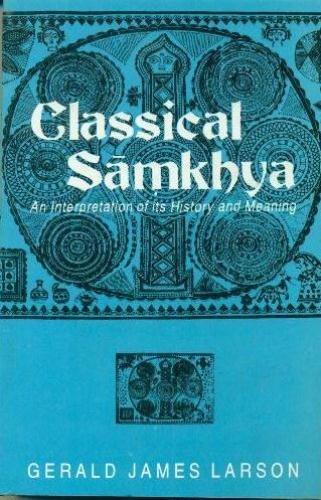Classical Samkhya: An Interpretation of its History and Meaning
![]() 100% Genuine New Books
100% Genuine New Books
![]() Fast Shipping with Tracking Number
Fast Shipping with Tracking Number
Secure Payments via UPI, Cards & Wallets
![]() Trusted Support & Easy Returns
Trusted Support & Easy Returns
Classical Samkhya: An Interpretation of its History and Meaning - Paperback is backordered and will ship as soon as it is back in stock.
ISBN : 9788120805026, 812080502x, 9788120805033, 8120805038
Year of Publication : 2014
Edition : Latest Reprint
No. of Pages : 332
Language : English
Condition : New
Publisher: Motilal Banarsidass Publishing House
Free shipping on orders over Rs. 249
Free shipping on orders over Rs. 249
We offer free shipping on orders above Rs. 249 in India. For orders below this threshold, a nominal shipping fee may apply, which will be clearly indicated during the checkout process.
How long will it take to receive my order?
How long will it take to receive my order?
The delivery time varies depending on your location. Generally, orders are processed and shipped within 1-3 business days. Once shipped, you can track and expect your order to arrive within 3-7 business days (the duration may vary depending on your location). For more information, please refer to our shipping policy.
Chat with a Real Person
Chat with a Real Person
WhatsApp chat is dedicated to assisting with after-sales queries regarding delivery, returns, and payments. Click below to initiate chat with us on WhatsApp:
[Bookstaa WhatsApp Chat].
For all other inquiries, please visit our customer support page or email us at support@bookstaa.com.
Couldn't load pickup availability
Description
Description
The tradition of Samkhya is one of the oldest and most influential in the intellectual history of India. The fundamental notions of Samkhya namely prakrti, purusa, buddhi, ahamkara, manas and the three gunas provided the conceptual framework in which much of Indian philosophizing occurred, and the classical formulations of Yoga and Vedanta together with many traditions of Buddhist philosophy and meditation developed vis-a-vis the intellectual perspective of the Samkhya. Similarly on a general cultural level the influence of Samkhya was profound and important over many centuries in such areas as law, medicine, ancient science and mathematics, logic, mythology, cosmology and ritual. This study traces the history of the Samkhya not only in the Indian intellectual tradition, but also in the traditions of historical criticism. The book also offers a new interpretation of the philosophical significance of the Samkhya, with special reference to the classical interpretation of the interaction of prakrti and purusa.
For the second editionthe author has also included a Chart of the Twenty-five Basic Principles of the Samkhya, a Glossary of Samkhya Terminology, an additional Appendix which surveys recent scholarly work in the area of Samkhya together with a discussion of Samkhya in the Purana-s and a revised Bibliography.
Review(s)
The term "Classical Samkhya" refers to the Samkhya doctrine as expounded in the Samkhyakarika of Isvarakrsna, together with the commentaries thereon. Author's own interpretation of the karika is given in a separate chapter. The original text of Samkhyakarika in Roman script together with a nice translation is given as an appendix. Glossary of technical terms, a chronological chart, bibliography and index make the work a highly useful one both to the Western and Eastern students of philosophy and research scholars for further studies. - B. Kutumba Rao, Triveni, July-September, 1984
Gerald Larson has here attempted to reconstruct and reinterpret the history and meaning of classical Samkhya. The special contribution of the book consists in showing Samkhya as system of religious thought which seeks to understand the world and man's place in the world from the perspective of the fact of consciousness. The author rightly argues that the dualism between consciousness and the world is fundamental. A useful inclusion in this edition of the book is the glossary of Samkhya terminology. The work is a useful addition to the growing literature on Indian thought in general and on the systems other than Vedanta in particular. - The Weekly-Madras, october 28, 1979
About the Author(s)
Gerald James Larson is Rabindranath Tagore Professor Emeritus, Indiana University, Bloomington, USA, and Professor Emeritus, Religious Studies, University of California, Santa Barbara.
About the Publisher

Motilal Banarsidass Publishing House (MLBD)
Motilal Banarsidass Publishing House, popularly known as MLBD, is one of the oldest and most prestigious publishing houses in India, established in 1903.
With over a century of legacy, MLBD has been at the forefront of publishing scholarly works in the fields of Indology, Sanskrit, philosophy, religion, spirituality, yoga, Buddhism, and Jainism.
Renowned for its authenticity and academic rigour, MLBD's books are trusted by researchers, scholars, and readers across the globe.
With more than 5,000 titles in circulation, MLBD continues to uphold its commitment to preserving and promoting India’s rich cultural and philosophical heritage.
Bookstaa is an authorized distributor of MLBD books, ensuring 100% genuine and original publications for our readers.

